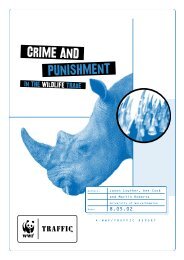In full swing: assessment of trade in orang-utans and ... - WWF UK
In full swing: assessment of trade in orang-utans and ... - WWF UK
In full swing: assessment of trade in orang-utans and ... - WWF UK
You also want an ePaper? Increase the reach of your titles
YUMPU automatically turns print PDFs into web optimized ePapers that Google loves.
law enforcement <strong>in</strong> <strong>In</strong>donesia is <strong>of</strong>ten lax some protected animals are more <strong>in</strong>cl<strong>in</strong>ed to be kept out <strong>of</strong> sight than others.<br />
The differences <strong>in</strong> openly display<strong>in</strong>g protected animals over the years <strong>and</strong> between markets may greatly affect detection<br />
probabilities dur<strong>in</strong>g market surveys. All these factors may contribute to changes <strong>in</strong> the number <strong>of</strong> gibbons <strong>and</strong> <strong>orang</strong><strong>utans</strong><br />
detected at bird markets over time, even when the volume <strong>of</strong> <strong>trade</strong> has rema<strong>in</strong>ed constant.<br />
On the other h<strong>and</strong>, for both gibbons <strong>and</strong> <strong>orang</strong>-<strong>utans</strong>, there does not seem to be a correlation between the <strong>in</strong>tensity <strong>of</strong><br />
monitor<strong>in</strong>g <strong>and</strong> the number <strong>of</strong> animals encountered. <strong>In</strong> years where a large number <strong>of</strong> surveys were completed, <strong>and</strong><br />
where many markets were visited, no more or fewer <strong>in</strong>dividuals were encountered. For gibbons, the <strong>in</strong>crease <strong>in</strong> the<br />
number <strong>of</strong> animals encountered appears to be constant <strong>and</strong> there is no break apparent which co<strong>in</strong>cides with, for<br />
example, the onset <strong>of</strong> the economic crisis (1997) or the establishment <strong>of</strong> the first wildlife rescue centres (2001).<br />
Furthermore, the pattern <strong>of</strong> <strong>in</strong>crease has been observed throughout Java. For <strong>orang</strong>-<strong>utans</strong>, no clear trend is apparent, but<br />
the data suggest that a relatively large number have been encountered at bird markets <strong>in</strong> recent years. However, there<br />
seem to be spatial differences, with an <strong>in</strong>crease noted for West <strong>and</strong> Central Java, but a decrease for East Java. Sample<br />
sizes for <strong>orang</strong>-<strong>utans</strong> were, however, considerably smaller than for the gibbons, possibly mask<strong>in</strong>g any real trends.<br />
<strong>In</strong>terviews with members <strong>of</strong> NGOs that have monitored the markets confirm the results presented above: for example,<br />
<strong>in</strong> the greater Jakarta area, it is believed that gibbons, <strong>and</strong> especially Siamangs, have been seen <strong>of</strong>fered for sale <strong>in</strong><br />
<strong>in</strong>creas<strong>in</strong>g numbers at bird markets <strong>in</strong> recent years. Siamangs were still frequently openly <strong>of</strong>fered for sale, whereas the<br />
<strong>trade</strong> <strong>in</strong> <strong>orang</strong>-<strong>utans</strong> had become an <strong>in</strong>creas<strong>in</strong>gly underground operation (Chairul Saleh, <strong>WWF</strong> <strong>In</strong>donesia, pers. comm.<br />
to V<strong>in</strong>cent Nijman, 2003). Along the northern coast <strong>of</strong> Central Java, there has been a significant <strong>in</strong>crease <strong>in</strong> numbers <strong>of</strong><br />
gibbons <strong>and</strong> <strong>orang</strong>-<strong>utans</strong> <strong>of</strong>fered for sale at bird markets <strong>in</strong> several cities s<strong>in</strong>ce early 2001 (Joko, PPSJ, pers. comm. to<br />
V<strong>in</strong>cent Nijman, 2003). For several cities throughout Java, the results <strong>of</strong> monitor<strong>in</strong>g programmes conducted over the<br />
past several years show that <strong>trade</strong> has <strong>in</strong>creased, both <strong>in</strong> the number <strong>of</strong> <strong>in</strong>dividuals, as well as the amount <strong>of</strong> money <strong>and</strong><br />
people <strong>in</strong>volved (R. Nursaid, Pr<strong>of</strong>auna Malang, pers. comm. to V<strong>in</strong>cent Nijman, 2003). Aga<strong>in</strong>, this trend was observed<br />
while the <strong>trade</strong> has become much less visible.<br />
Taken together, these data suggest that there is a high likelihood that the <strong>trade</strong> <strong>in</strong> gibbons <strong>and</strong> Siamang on Java <strong>and</strong> Bali<br />
has <strong>in</strong>deed significantly <strong>in</strong>creased over the last ten years, whereas the data are <strong>in</strong>conclusive for <strong>orang</strong>-<strong>utans</strong>.<br />
There were few consistent trends <strong>in</strong> the variation <strong>of</strong> quoted prices over the years (Figure 8). For those three species for<br />
which data was available for three or more years (Agile Gibbon, Siamang <strong>and</strong> Bornean Orang-utan), the variation <strong>in</strong><br />
quoted prices was large <strong>and</strong> for some species the variation with<strong>in</strong> years was as large as the variation between years.<br />
Hence, there is no <strong>in</strong>dication <strong>of</strong> either an <strong>in</strong>crease or decrease <strong>in</strong> quoted prices <strong>of</strong> gibbons <strong>and</strong> <strong>orang</strong>-<strong>utans</strong>.<br />
IN FULL SWING:ASSESSMENT OF TRADE IN ORANGUTANS AND GIBBONS ON JAVA AND BALI,INDONESIA 22


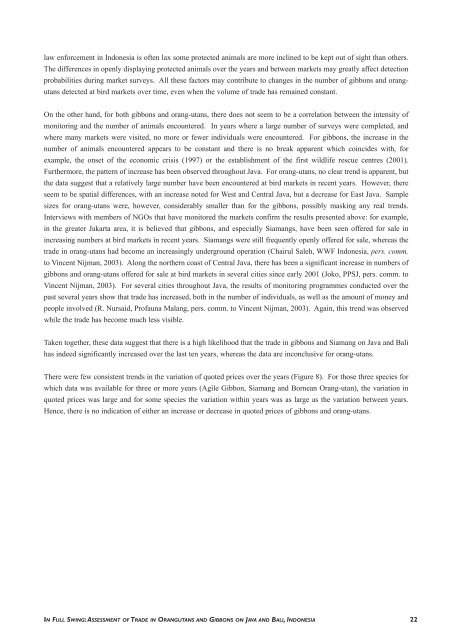
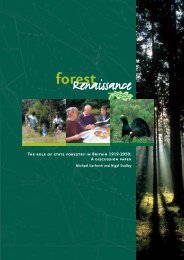
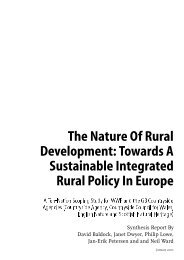
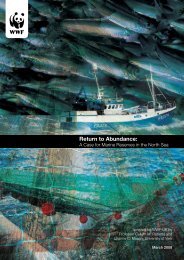

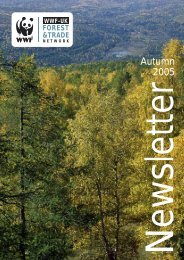

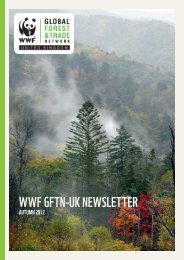
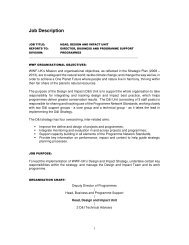
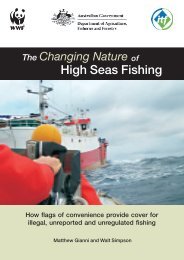
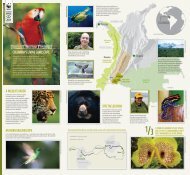
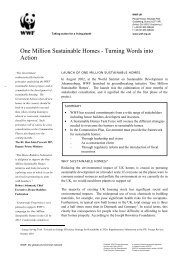
![[PDF] Causes for concern: chemicals and wildlife - WWF UK](https://img.yumpu.com/31929970/1/184x260/pdf-causes-for-concern-chemicals-and-wildlife-wwf-uk.jpg?quality=85)
